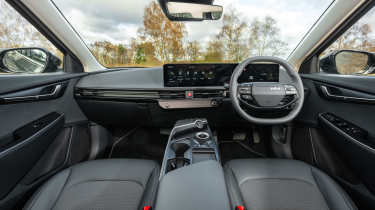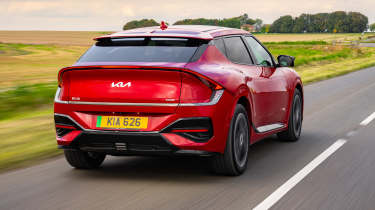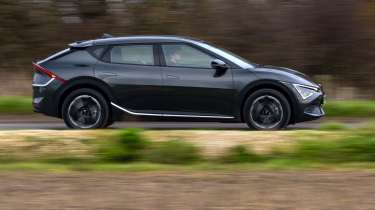Kia EV6 2025 review – still want that Tesla Model Y?
The standard Kia EV6 is a rounded and fundamentally sound electric car, giving some more ‘premium’ rivals a run for their money
The new 577bhp EV6 GT with its Hyundai Ioniq 5 N-derived powertrain has stolen the limelight, but the standard EV6 remains one of the best everyday EVs money can buy. Taking the Ioniq 5’s excellent platform, applying it to a sleeker body style and giving it more refined dynamics from the bottom of the range, it gives those in the market for a practical electric crossover like the Tesla Model Y and Volkswagen ID.4 food for thought.
Like its Hyundai relative, the Ioniq is much larger in reality than it looks in pictures. Its wheels can look a little lost in the arches and while the lighting elements look sleek, sharp and delicate, in reality it’s all quite substantial, upsized to hide the overall body’s true dimensions. To my eyes, the design of the Hyundai Ioniq 5 remains leagues ahead of the EV6, more cohesive, playful and with its detailing more refined, but then looks aren’t everything.
> Kia EV6 GT 2025 review – Hyundai Ioniq 5 N parts make for a genuinely fun EV
Interior and tech
If you’re familiar with the Hyundai Ioniq 5, or any model on the e-GMP platform for that matter, you’ll feel at home in an EV6. Certain mouldings and design touches are specific to the EV6, but overall architecture is near-identical to its Hyundai counterpart, with well-considered ergonomics, a clean design and a surprising number of physical buttons for (most) vital functions – the physical climate control buttons of the Hyundai are swapped for a touch panel, though, which won’t be for some. There’s a dual 12.3-inch screen set-up augmented with physical controls both on the dash and the floating centre console, and the system works very well on the whole – the HMI isn’t the slickest on the market and the assistance system chimes are especially frustrating, but you quickly become familiar given some miles.
More reviews
The EV6 feels just as spacious as the Ioniq 5 inside, but where it differs is in its materials. While the EV6 GT-Line we tested is undoubtedly more sporty in aesthetic, it goes without the premium-feel, cold-touch metal stalks and gear selector of the Hyundai (the latter is a rotary dial in the centre console in the EV6 as opposed to a column-mounted twist stalk). Combine this with the reduction in physical buttons and it does feel like a step down in some ways. Regardless, it’s a comfortable, spacious and tech-filled cabin that still makes some more ‘premium’ offerings look poorly designed.
Performance, ride and handling
The chassis is where the real money has been spent with this car, and you can feel it. Underpinned by Hyundai and Kia’s jointly developed e-GMP platform, it was developed to form the basis of multiple models across both brands, and premium offshoot Genesis. In the case of the EV6, its hardware might be largely the same as that of Hyundai’s Ioniq 5, but the shorter wheelbase and fundamentally sound chassis tuning has yielded big benefits, with the EV6 feeling much more spritely and composed than its somewhat dowdy looks might suggest.
The steering is natural and accurate, if exceedingly light, with a linear rise in steering weight as the load on the front tyres increases. This weight, and the ratio’s speed itself, feels extremely well calibrated to the body and its movements as you flow through a corner. Ride improves with speed in our experience, with the EV6 managing its 2.1 ton weight figure well on a B-road (the battery alone weighs 476kg…). At lower speeds we find it to be less calm than the Ioniq 5, and refinement isn’t quite on a par either – there’s significantly less padding in the arch liners in this EV6 GT-Line we tested, something that was made very clear each time we passed over loose chippings and road debris.
Powertrain and technical highlights
Kia’s experience with EVs shines most brightly in the brake pedal feel and throttle calibration, both of which are standout amongst all electric cars regardless of price. No EV does such a good job of blending the regenerative and friction braking systems, the pedal has no discernable change in feedback throughout the travel and the brakes themselves are also immensely strong, giving you extreme confidence, whether coming to a smooth stop at a junction or entering a corner at speed. One pedal driving is also available at the click of the left hand steering wheel paddle, and is as well-judged as every other driving mode.
The throttle is equally well-considered, with the pedal feel and response changing between the drive modes, but each with an intuitive and resolved feel. We did see an occasional delay in throttle response from a standstill in our test car, which was slightly disconcerting, but on the move response is excellent. Actual performance is impressive too, with the middling GT-Line we tested achieving a 5.3sec 0-62mph sprint despite a modest 320bhp output (a 446lb ft torque figure will help matters) – it feels genuinely quick in Sport mode both from a standstill and on the move, with that satisfying kick we’ve become accustomed to in more potent EVs. Knock it into comfort or eco though, and it becomes a docile, soft-edged family car.
On a drive with a combination of motorway miles, quick b-roads and low speed town driving, we saw average efficiency of 3.2mi/kWh, not quite the 3.7 combined figure quoted by Kia. Regardless, range estimation is among the most accurate of any EV we’ve tried, which helps reduce any potential range anxiety. Our car displayed a maximum range of 270 miles fully charged, a good chunk less than the 339 WLTP figure quoted, but of course, your mileage will quite literally vary. Charging speed of up to 350kw also put it up there with the best EVs on sale today, which is always handy.
What the EV6 feels like is an electric car developed by a team that had a clear idea of what they wanted the car to be from its inception, backed up by the experience and budget to execute it properly. In contrast to its bizarre undefined form, it really is a very impressive family car of the future that does everything it needs to as a solid, reliable and satisfying everyday car for the everyday consumer.
Price, specs and rivals
Having just received a mid-life update in 2025, the Kia EV6 range now starts with the 'Air' trim level, available with a smaller 63kWh battery pack and a very modest 167bhp output – the benefit of this, though, is a £39,235 price tag, a great price for an awful lot of car if you're not fussed about performance. If you'd like a little more poke (225bhp to be precise) and a larger 84kWh battery pack, you'll pay £45,585.
The rest of the EV6 range is available only with the larger 84kWh battery pack, moving up to GT-Line with a choice of the same 225bhp RWD powertrain and the 320bhp AWD option we tested (available for £48,585 and £52,085 respectively). GT-Line S tops the standard range, offering the same two powertrains as the GT-Line, only with the option of a heat pump in both for a premium of around £4000 across the board. Increase the budget a little more and the 577bhp EV6 GT is within reach at £59,985, borrowing its powertrain from the excellent Hyundai Ioniq 5 N.
There are plenty of rivals to choose from, ranging from the Tesla Model Y to the Ford Mustang Mach-E and BMW iX2 if size isn’t an issue for you. The Tesla offers strong performance and efficiency but starts at a higher £44,990. The Mustang Mach E is less impressive on paper with a reduction in range and output, but still starts at a higher £43,840 price point, and despite its smaller size, less advanced electrical architecture and lower 267-mile WLTP range figure, even the basic BMW iX2 M Sport struggles to compete with an even higher £49,455 starting price.



